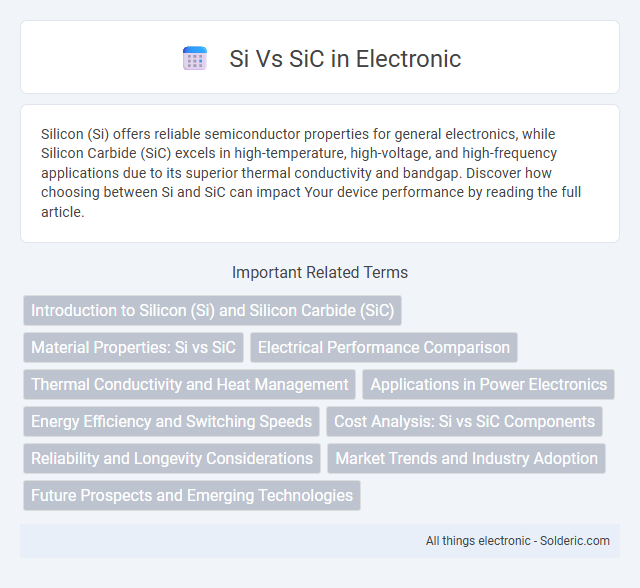Silicon (Si) offers reliable semiconductor properties for general electronics, while Silicon Carbide (SiC) excels in high-temperature, high-voltage, and high-frequency applications due to its superior thermal conductivity and bandgap. Discover how choosing between Si and SiC can impact Your device performance by reading the full article.
Comparison Table
| Feature | Silicon (Si) | Silicon Carbide (SiC) |
|---|---|---|
| Bandgap | 1.1 eV | 3.26 eV |
| Thermal Conductivity | 150 W/m*K | 490 W/m*K |
| Maximum Junction Temperature | ~150degC | > 300degC |
| Electric Breakdown Field | 0.3 MV/cm | 3 MV/cm |
| Switching Speed | Moderate | High |
| Cost | Lower | Higher |
| Applications | General electronics, low power devices | High power electronics, electric vehicles, industrial, aerospace |
Introduction to Silicon (Si) and Silicon Carbide (SiC)
Silicon (Si) is a widely used semiconductor material known for its excellent electrical conductivity and cost-effective production, making it the foundation of most traditional electronic devices. Silicon Carbide (SiC), a compound of silicon and carbon, offers superior thermal conductivity, higher breakdown voltage, and greater efficiency in high-power and high-temperature applications. By choosing SiC over Si, your electronic systems can achieve enhanced performance, especially in demanding environments requiring robust reliability and energy savings.
Material Properties: Si vs SiC
Silicon (Si) exhibits a bandgap of 1.1 eV, thermal conductivity of 150 W/mK, and electron mobility around 1500 cm2/Vs, making it suitable for low-power semiconductor devices. Silicon carbide (SiC) offers a wider bandgap of 3.26 eV, higher thermal conductivity approximately 490 W/mK, and electron mobility near 650 cm2/Vs, enabling superior performance in high-temperature and high-power applications. The inherent hardness and chemical stability of SiC also surpass Si, contributing to its reliability in harsh environments.
Electrical Performance Comparison
Silicon Carbide (SiC) offers superior electrical performance compared to Silicon (Si), featuring higher breakdown voltage, faster switching speeds, and lower on-resistance, which results in increased efficiency for power electronics. SiC devices maintain excellent performance at elevated temperatures and high frequencies, making them ideal for demanding applications such as electric vehicles and renewable energy systems. Your choice of SiC over Si can significantly enhance the reliability and energy efficiency of high-power electronic circuits.
Thermal Conductivity and Heat Management
Silicon carbide (SiC) exhibits significantly higher thermal conductivity, approximately 3.7 W/cm*K, compared to silicon's (Si) 1.5 W/cm*K, enabling more efficient heat dissipation in high-power and high-temperature applications. Enhanced heat management in SiC devices reduces thermal resistance and improves reliability and performance stability under extreme operating conditions. This superior thermal conductivity supports compact system designs by minimizing the need for bulky cooling solutions.
Applications in Power Electronics
Silicon (Si) dominates traditional power electronics applications such as power supplies, motor drives, and automotive controllers due to its mature fabrication technology and cost-effectiveness. Silicon Carbide (SiC) offers superior performance in high voltage, high temperature, and high frequency environments, making it ideal for electric vehicle inverters, renewable energy systems, and industrial power conversion. SiC's higher breakdown electric field, thermal conductivity, and switching efficiency significantly improve energy efficiency and reduce cooling requirements in advanced power electronic devices.
Energy Efficiency and Switching Speeds
Silicon carbide (SiC) devices offer significantly higher energy efficiency compared to traditional silicon (Si) components due to lower conduction and switching losses, which is critical for power electronics applications. SiC's ability to operate at higher switching speeds reduces energy dissipation and improves overall system performance, making it ideal for high-frequency converters and inverters. Your choice of SiC technology can enhance energy-saving measures and optimize fast switching requirements in demanding electrical systems.
Cost Analysis: Si vs SiC Components
Si components generally have a lower upfront cost compared to SiC due to mature manufacturing processes and widespread availability. SiC components, despite higher initial prices, offer superior efficiency and thermal performance, potentially reducing long-term operational expenses and cooling system costs. Your choice between Si and SiC should consider both immediate budget constraints and total cost of ownership for optimized financial outcomes.
Reliability and Longevity Considerations
Silicon carbide (SiC) devices exhibit superior reliability and longevity compared to silicon (Si) due to their higher thermal conductivity and greater resistance to thermal cycling and electrical stress. SiC's wide bandgap enables operation at higher temperatures and voltages without significant degradation, extending device lifespan in demanding industrial and automotive applications. Your choice of SiC over Si can lead to reduced maintenance costs and improved system uptime in high-performance power electronics.
Market Trends and Industry Adoption
Silicon (Si) remains dominant in mainstream electronics due to its well-established manufacturing infrastructure and cost efficiency, particularly in consumer and computing applications. Silicon Carbide (SiC) is gaining rapid traction in high-performance sectors such as electric vehicles (EVs), renewable energy, and industrial power electronics because of its superior thermal conductivity, higher switching frequencies, and enhanced efficiency under high voltage conditions. Market forecasts project a compound annual growth rate (CAGR) exceeding 30% for SiC devices through 2030, driven by increasing demand for energy-efficient power solutions and government mandates on emission reductions.
Future Prospects and Emerging Technologies
Silicon Carbide (SiC) offers significant advantages over Silicon (Si) in power electronics due to its higher thermal conductivity, wider bandgap, and superior breakdown electric field, enabling devices to operate at higher voltages, frequencies, and temperatures. Emerging technologies like SiC-based MOSFETs and Schottky diodes are revolutionizing electric vehicles and renewable energy systems by improving efficiency and reducing energy loss. Your adoption of SiC components can accelerate innovation in industrial applications, fostering advances in smart grids and fast-charging infrastructure.
Si vs SiC Infographic

 solderic.com
solderic.com